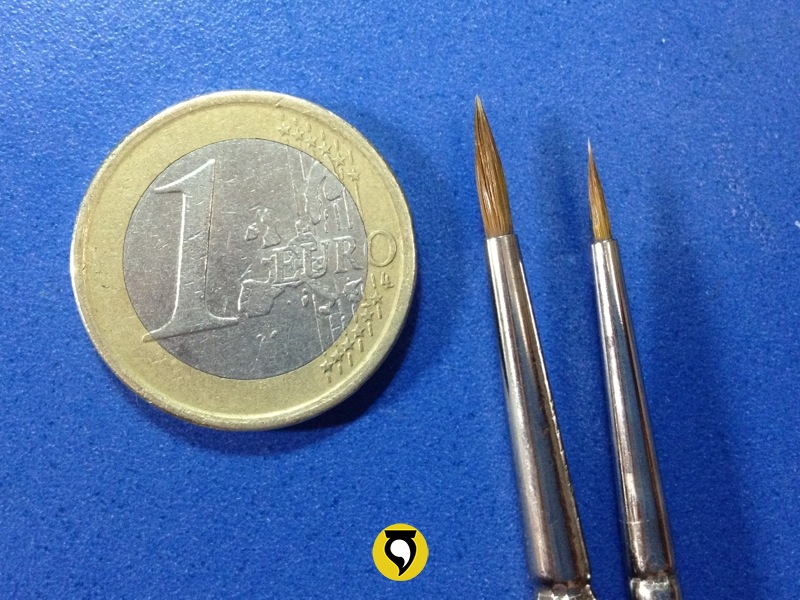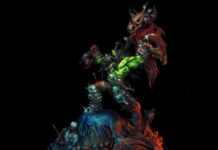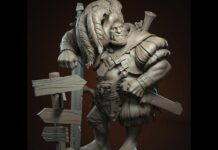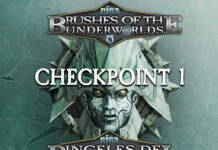One of the most basic concepts in miniature painting is the proper way to use a paintbrush. The speed and quality of our painting depends on how well we know how to use it. Specially crucial is to control the brushstroke when we choose a style of miniature painting based on layers or gradients, because in these cases the way we lay our brushstroke is the key of the process. Other styles like pointillism or wet painting permit us more freedom when choosing the brushstroke, but we should take into consideration how the use our paintbrush will affect our choice.

When using a miniature painting style based on layers, the first myth that needs to be broken is that the brush needs to be small. We are actually going to prefer using a brush with a big head, capable of loading a decent quantity of paint so that we don’t have to go back to our palette every time we give a stroke. We will also prefer longer hairs because we are going to paint with the brush horizontally, using the pointed tip of the brush only when strictly necessary. Small brushes with short and little hair, though pointy, do not have enough capacity for paint loading and they will rarely keep paint wet from the palette to the miniature.

To apply a paint layer, the brushstroke will be performed describing a plane instead of a line, we don’t want to drag the tip of the brush, we do it laterally. With a wider brushstroke, paint will cover and distribute more homogeneously and we will take advantage of the load capacity of a good brush. Also, we will control better the pigment distribution this way.

With every brushstroke, we’ll notice that at the end of the stroke, just before lifting the brush from the painting surface, we are dropping the biggest quantity of paint. The colour drop will be bigger the more we load the brush. This is a paint drop which could spoil a good job that seemed smooth if we don’t control it. However, now that we know about it, we can use for our own benefit. If we are, for example, trying to do some shadows, we will make sure that the direction of the brushstroke is that which leaves that final colour drop in the area of maximum shadow, for the colour we are painting. The same will occur when painting lights.
If what we want to achieve is a homogeneous colour plane, the best thing to do is dilute the paint as much as possible. We need to master brush-stroking to be able to apply semitransparent layers of paint. Brush-stroking in planes or semi-planes is also key in this case. What we will control carefully is the dilution of paint, and the quantity of paint that the brush will load when painting. The more diluted the paint is, the more transparent the layer will be, and as we reduce the quantity of paint in the brush, the more control we will have over the effect and faster the process will be, because the paint will dry faster. If we load the brush too much, we have the risk of soaking instead of painting, and when there’s too much water which does not dry fast on the miniature, the dissolved pigment will not be homogeneously distributed, it will disperse and create paint stains.

The most important thing to consider when we are layering in miniature painting is that we need to let each layer of paint dry before applying the next one. With every brushstroke we will deposit wet paint on the surface and if we use the brush again over that same surface before the paint has dried, instead of depositing more paint we will be moving around the paint previously applied.
Whatever our ability with the brush may be, the state and quality of our brush is fundamental, we must never be careless about it because this can be a continuous reason for frustration, or even a limitation for our miniature painting skills.




























Thank you, Thank you, Thank you. I have seen so much video how to do layering, but this is the best explanation I have seen 🙂
Thank you Vorganov! I’m glad you liked it 🙂
This is a simple but brilliant lesson and observation. Thank you for taking the time to explain this.
Thank you for reading! 🙂
Very good lesson. Keep up the good work.
Thanks Christoph! I’m glad you liked it 🙂
[…] Originally posted by Volomir at http://volomir.com/en/layering-brushtroke-miniature-painting/ […]
more usefull tip than the videos i ve seen!!thanks a lot!!!
I’m glad this was useful to you! Thanks thanos telis!
So where does this leave flow improver or slo-dri? Is there a different brush technique if the the paint is more susceptible to moving with subsequent layers? In this case are we preparing the paint to move in some fashion to get better blends? How do you best take advantage of additive benefits without wrecking a mini with moving paint? Obviously, we shouldn’t be scrubbing the mini with the brush. Will a little matte medium help keep things in place?
Hi Bob! Sorry to have missed your comment! Basically flow improver will reduce the amount of paint at the end drop. You can either consider all that I explain in the article, or use flow improver. I personally am not a big fan of flow improvers but it all depends on your painting style. I learnt to paint without using them and then it just makes it more difficult for me because I am used to moving the drop around, but I understand some people might be pleased by using it. Also, the way the paint dries depends on air humidity levels. Here in Madrid, paint dries very fast so layering is very useful. If layers do not dry fast enough, you might want to try other blending techniques such as wet blending, because it might be faster in your case. Anyhow, the important thing here is to know your drop and understand how to place it conveniently. I hope this answers your questions! If not, please let me know 🙂 Thanks for commenting!
I think each newbie in your hobbie should read it before anything else.
If I had read your articles 10 years ago, I would save a lot of frustration becoming crazy with my triple 0.
It’s probably the first mistake we’ve all done: buy the tiniest brush available.
Great article, short and clear.
Thanks Carkel! 🙂
[…] Volomir’s Article on Brush Strokes: http://volomir.com/en/layering-brushtroke-miniature-painting/ […]
Excellent instruction Volomir. Looking forward to trying it out.
Thanks for commenting Tom! I hope it helps you! 🙂
Like your article a lot. Will try things you mention as soon as possible.
Thinning paint even more.
Not so much paint loaded on the brush (to avoid stains, I had them a lot)
Thanks from a beginner from Hamburg, Germany.
Thank you for commenting Dr00g! Would love to know about the results after you try these! 😀
How wonderful ! Discover your site trough FB , and now I see here a lot to explore and learn ! Great Tutorial here , very enlightening , thank you ! Now to check more 🙂
Thanks António! We will keep them coming! Don’t forget to check regularly for more! 🙂 Very happy that you like it and thanks for commenting! 🙂
[…] http://volomir.com/en/layering-brushtroke-miniature-painting/ […]
For a hobby painter who always used paint the wrong ways just to paint this was a great read. I found your links from watching a few you tube painters, but all of these techniques are overwhelming. How would you suggest someone with little skill to learn this technique?
There is only one way to learn: pratice practice practice and more practice!
Having some kind of coach or mentor will also do wonders. They can correct you and guide you to improve your ways.
I also recommend attending a workshop of any of your faourite painters, that is an experience that changes your painting life.
I hope this helps!
It sounds soo simple but the tip is very useful. Im very excited to read more of your advices! Did you post about technics in painting miniatures for beginners?